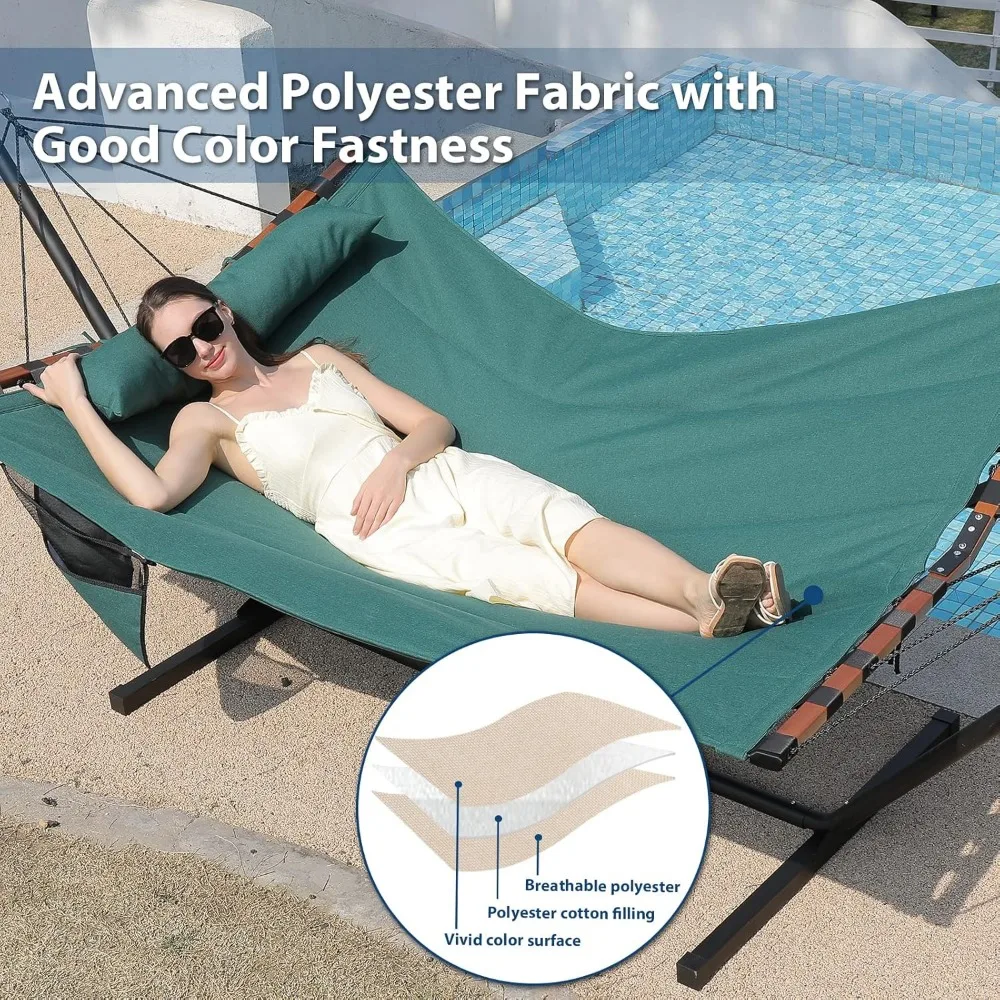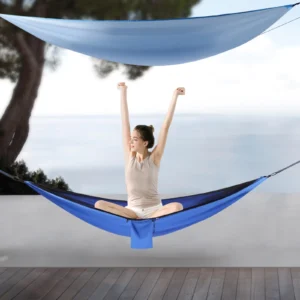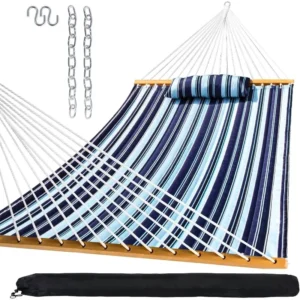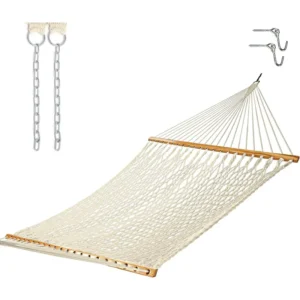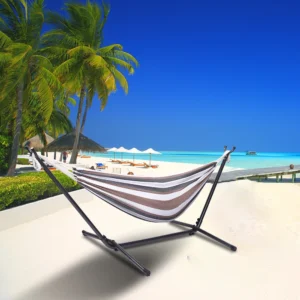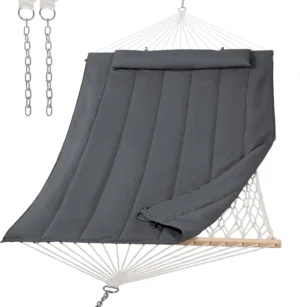Why Material Selection Makes or Breaks Your Outdoor Hammock Experience
Imagine yourself on a perfect summer afternoon, gently swaying in your hammock under dappled shade. The breeze is just right, birds are singing, and you’re completely at peace—until you shift positions and feel the scratchy, uncomfortable fabric against your skin, or worse, hear the alarming sound of tearing as your hammock gives way beneath you.
The material of your outdoor hammock isn’t just a small detail—it’s the foundation of your entire relaxation experience. It determines whether you’ll enjoy years of blissful outdoor napping or face disappointment after just one season. The right material stands strong against harsh sunlight, repels rainwater, resists mold in humid conditions, and still feels wonderful against your skin.
Your outdoor environment poses unique challenges that indoor hammocks never face. Materials that work perfectly on a covered porch might quickly deteriorate when exposed to direct sunlight or frequent rain. Understanding how different materials perform in various indoor and outdoor hammock placements will save you from replacing your hammock prematurely and ensure your relaxation spot remains perfect season after season.
Essential Material Qualities for Outdoor Hammocks: What Really Matters
When selecting an outdoor hammock material, several crucial factors will determine how well it performs in real-world conditions:
Weather Resistance
- UV Stability: Sunlight breaks down most materials over time. Superior materials resist fading and degradation from the sun’s harsh rays.
- Water Resistance: How quickly does the material dry after rain? Does it absorb moisture or allow it to bead off?
- Mold/Mildew Resistance: Certain materials naturally resist fungal growth, while others become breeding grounds when damp.
Durability Factors
- Tear Strength: The ability to resist ripping when caught on sharp objects or when supporting weight.
- Abrasion Resistance: How well the material withstands repeated friction without wearing thin.
- Weight Capacity: Directly related to material strength and construction quality.
Comfort Elements
- Texture: Is the material soft against skin, or does it feel rough or synthetic?
- Breathability: How well air circulates through the fabric, preventing that “sticky” feeling on hot days.
- Stretch: Some materials offer a gentle “give” that contours to your body, while others provide firmer support.
Maintenance requirements vary dramatically between materials. Some require regular cleaning and storage during inclement weather, while others can remain outdoors year-round with minimal care. This becomes particularly important when considering whether it’s okay to leave your hammock outside during different seasons.
For portable hammocks, weight and packability matter significantly. A hammock that’s perfect for your backyard might be completely impractical for camping or travel due to its material weight and bulk.
These qualities form the evaluation framework we’ll use to examine each hammock material in detail, helping you make the best choice for your specific outdoor situation.
Natural Fiber Hammocks: Traditional Comfort with Outdoor Limitations
Cotton Hammocks
Cotton represents the traditional hammock material, beloved for its exceptional softness and comfort. When you sink into a cotton hammock, you’re experiencing the material that defined hammock relaxation for generations.
Pros:
* Unmatched softness against skin
* Breathable fabric that stays cool in summer
* Often more affordable than specialty synthetics
* Traditional, authentic aesthetic
* Becomes softer with each wash
Cons:
* Highly susceptible to mold and mildew when wet
* Retains moisture for hours or even days
* Deteriorates quickly with UV exposure
* Requires removal during rain or high humidity
* Needs regular cleaning and proper storage
Cotton hammocks perform best in protected settings like covered porches, sunrooms, or for occasional fair-weather use with diligent storage practices. Some users love the authentic feel of cotton so much that they accept the higher maintenance requirements.
Canvas Hammocks
Canvas offers a sturdier natural option that bridges the gap between cotton’s comfort and synthetic durability. It’s essentially a heavier, more tightly woven cotton or cotton blend.
Pros:
* Greater durability than standard cotton
* Better tear resistance and longevity
* Classic, rustic appearance
* Good comfort level with medium-soft feel
* Typically more resistant to stretching over time
Cons:
* Still vulnerable to moisture damage and mold
* Heavier than most other hammock materials
* Requires regular maintenance and seasonal storage
* Not as soft as standard cotton
* Longer drying time after exposure to moisture
Canvas hammocks work well in semi-protected outdoor spaces where they won’t be exposed to frequent rain but might encounter occasional moisture. With proper care, they can last significantly longer than standard cotton while maintaining much of the natural comfort factor.
While natural fibers excel in comfort, they generally struggle with outdoor resilience. For hammocks that will see significant outdoor exposure, you might want to explore our selection of quilted fabric hammock sets that balance comfort with better durability.
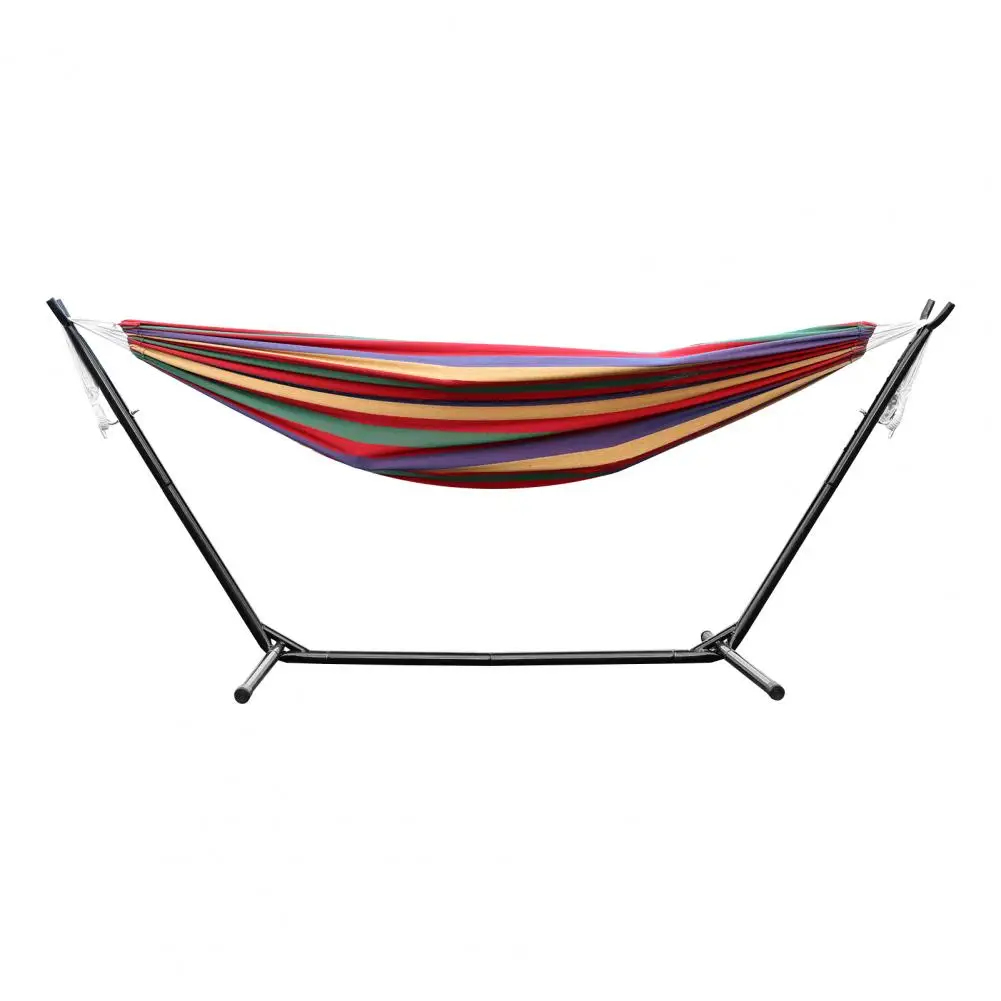
Synthetic Materials: Engineered for Outdoor Performance
A. Polyester
Polyester has become one of the most common outdoor hammock materials due to its excellent balance of performance characteristics and affordability.
Pros:
* Excellent UV resistance with minimal fading
* Quick-drying properties after rain or morning dew
* Good durability and tear resistance
* Retains colors well for years
* Relatively affordable compared to premium synthetics
* Available in countless colors and patterns
Cons:
* Less breathable than natural fibers
* Can feel slightly rough against bare skin
* Moderate rather than exceptional in most categories
* May develop static electricity in very dry conditions
Polyester hammocks offer reliable all-around performance without excelling dramatically in any single category. They’re the practical choice for most casual outdoor users who want good durability without premium pricing. You’ll find these versatile options in our fabric hammock sets collection.
B. Nylon and Ripstop Nylon
Nylon offers remarkable strength-to-weight ratio, making it the preferred choice for portable hammocks and camping applications.
Pros:
* Incredible strength despite lightweight construction
* Superior packability for travel and hiking
* Excellent tear resistance (especially ripstop varieties)
* Quick-drying capabilities
* Good breathability during hot weather
Cons:
* Less UV resistant than polyester without special treatments
* Can feel slippery or synthetic against skin
* May make rustling sounds with movement
* Generally less aesthetically pleasing than other options
* Tends to stretch slightly with use
Ripstop nylon features a special reinforced weave that prevents small tears from spreading. These reinforced threads create the characteristic gridded appearance while dramatically improving durability. Nylon hammocks shine in portable applications where weight matters but remain a solid choice for permanent outdoor setups with proper care.
C. Polypropylene (Olefin)
Polypropylene excels in wet environments, making it perfect for poolside, beachfront, or rainy climate applications.
Pros:
* Nearly waterproof with minimal absorption
* Highly resistant to mold and mildew
* Excellent stain resistance
* Good chemical resistance (chlorine, salt water)
* Typically more affordable than other specialty synthetics
Cons:
* Less comfortable against skin than other options
* Can become uncomfortably hot in direct sun
* Moderate UV resistance without special treatments
* Less color variety typically available
* Can feel somewhat rigid compared to other fabrics
If your hammock will be exposed to frequent moisture or placed near water features, polypropylene offers significant advantages. Its quick-drying properties and mold resistance make it ideal for humid environments where other materials would quickly deteriorate.
D. Premium Acrylics (Sunbrella®, etc.)
Solution-dyed acrylic fabrics represent the gold standard for outdoor performance, combining exceptional durability with surprising comfort.
Pros:
* Superior UV resistance with minimal fading for years
* Excellent water repellency while maintaining breathability
* Exceptional longevity even in harsh conditions
* Resist mildew and staining better than most materials
* Feel softer than most other synthetics
Cons:
* Significantly higher cost than standard materials
* Heavier than nylon options
* Not ideal for portable applications
* Fewer color/pattern options than polyester
* May require special cleaning methods
Premium acrylics achieve their remarkable performance through a manufacturing process where color is added to the fiber solution before extrusion, rather than dyeing the finished fabric. This creates color that permeates the entire fiber instead of just coating the surface, resulting in exceptional fade resistance. For permanent outdoor installations where quality matters more than price, premium acrylics justify their higher cost through years of reliable service.
E. Textilene and Mesh Options
Open-weave synthetic mesh materials provide unique benefits for specific outdoor applications, especially in hot or humid climates.
Pros:
* Exceptional airflow and breathability
* Extremely fast drying after rain
* No moisture retention to encourage mold growth
* Excellent visibility through the hammock
* Very low maintenance requirements
Cons:
* Less cozy feel than solid fabrics
* Leaves imprint patterns on skin during longer use
* Limited insulation in cooler weather
* Smaller objects can fall through openings
* Less privacy than solid materials
Textilene and similar mesh fabrics work particularly well for poolside hammocks, beach installations, or extremely humid environments. The open weave allows water to pass through rather than absorb, while maximizing airflow to keep you cool. For hot climate installations, these materials offer practical benefits that outweigh their somewhat utilitarian feel. For more specific information on waterproof materials for hammock protection, we’ve created a comprehensive guide.
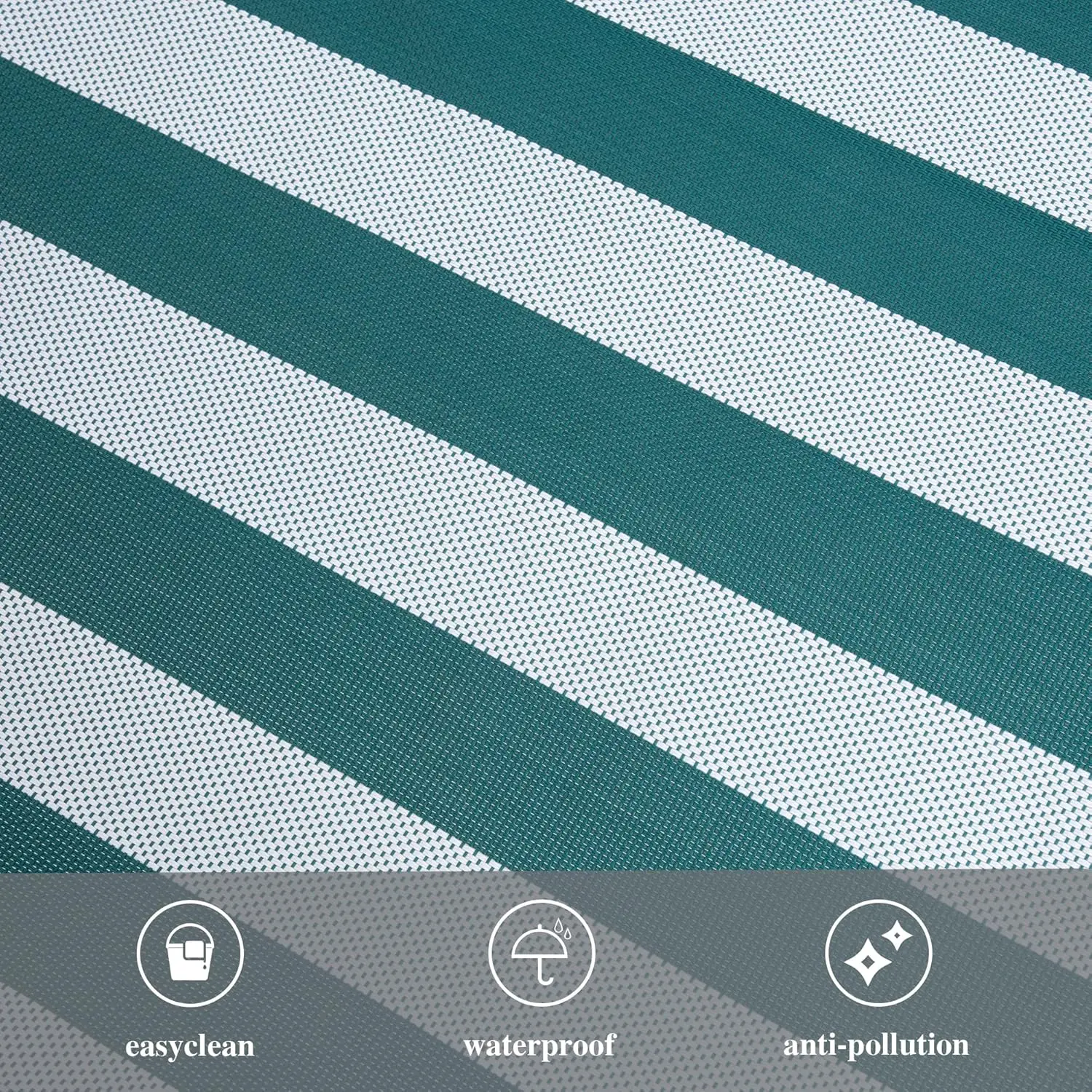
Blended and Specialty Materials: Combining Benefits
Manufacturers continually innovate to create hammock materials that balance the best properties of different fibers. These hybrid options offer interesting compromises that might provide the perfect solution for your specific needs.
Polyester-Cotton Blends
These popular blends typically contain 60-70% polyester with 30-40% cotton, creating a material that bridges the gap between comfort and durability.
- More comfortable against skin than pure polyester
- Better weather resistance than pure cotton
- Moderate drying time (faster than cotton, slower than synthetic)
- Good balance between natural feel and practical performance
- Requires less maintenance than pure natural fibers
Blend ratios significantly impact performance—higher polyester percentages improve weather resistance while higher cotton content enhances comfort. These blends make excellent choices for hammocks that will see occasional weather exposure but are primarily used in fair conditions.
Quilted Constructions
Specialty quilted hammocks feature multiple material layers stitched together to enhance comfort:
- Soft top layer maximizes comfort against skin
- Weather-resistant bottom layer protects against ground moisture
- Internal padding adds cushioning and insulation
- Different materials can be used for top and bottom layers
- Generally thicker and more substantial feel
Quilted hammocks excel in comfort but typically require more protection from severe weather due to their construction complexity. Our detailed guide on choosing outdoor fabric hammocks explores these options in greater depth.
The perfect blend often depends on your specific priorities and usage patterns. Hybrids and specialty constructions can offer the best of multiple worlds for those willing to explore beyond standard single-material options.
Ultimate Material Comparison: Side-by-Side Assessment
This comparison helps you quickly evaluate key performance factors across all common hammock materials:
| Material | Weather Resistance | Durability | Comfort | Maintenance | Price Range | Best For |
|---|---|---|---|---|---|---|
| Cotton | ★☆☆☆☆ | ★★☆☆☆ | ★★★★★ | High | $ | Protected areas, occasional use |
| Canvas | ★★☆☆☆ | ★★★☆☆ | ★★★★☆ | Medium-High | $-$$ | Semi-protected spaces, traditional look |
| Polyester | ★★★★☆ | ★★★★☆ | ★★★☆☆ | Low | $$ | All-purpose outdoor use, value seekers |
| Nylon | ★★★☆☆ | ★★★★☆ | ★★☆☆☆ | Low | $$-$$$ | Camping, travel, lightweight needs |
| Polypropylene | ★★★★☆ | ★★★☆☆ | ★★☆☆☆ | Very Low | $$-$$$ | Wet environments, poolside use |
| Premium Acrylic | ★★★★★ | ★★★★★ | ★★★★☆ | Low | $$$-$$$$ | Permanent installations, premium setups |
| Textilene Mesh | ★★★★★ | ★★★★☆ | ★★☆☆☆ | Very Low | $$-$$$ | Hot climates, maximum airflow needs |
| Poly-Cotton Blend | ★★★☆☆ | ★★★☆☆ | ★★★★☆ | Medium | $$-$$$ | Balance of comfort and durability |
When selecting your hammock material, consider how these ratings align with your specific priorities and intended use. Remember that hammock installation requirements and safety considerations may also influence your material choice based on weight capacity and intended mounting location.
Perfect Material Matches for Specific Outdoor Settings
For Permanent Year-Round Outdoor Installation
Best Choice: Premium Acrylic (Sunbrella®)
Premium acrylic fabrics withstand constant exposure to elements with minimal degradation, maintaining their appearance and strength for years even in challenging weather conditions.
For Rainy and Humid Environments
Best Choice: Polypropylene or Textilene Mesh
These materials resist water absorption and dry extremely quickly, preventing the mold and mildew growth that would quickly destroy natural fibers in these conditions.
For Intense Sun Exposure
Best Choice: Premium Acrylic or Treated Polyester
Solution-dyed acrylics and UV-treated polyesters resist fading and degradation from intense sunlight, maintaining their color and strength where other materials would quickly deteriorate.
For Portability and Travel
Best Choice: Ripstop Nylon
Nothing matches the strength-to-weight ratio of quality ripstop nylon, making it ideal for ultralight camping hammock sets where every ounce matters during transport.
For Maximum Comfort with Proper Care
Best Choice: Cotton or Poly-Cotton Blend
Pure cotton offers unmatched softness for those willing to bring their hammock in during inclement weather, while poly-cotton blends provide a good compromise between comfort and weather resistance.
For Budget-Conscious Consumers
Best Choice: Standard Polyester
Quality polyester hammocks offer the best balance of durability, weather resistance, and affordability, making them excellent value for casual outdoor use.
For Minimal Maintenance
Best Choice: Textilene Mesh or Polypropylene
These materials can be left outdoors with virtually no special care, requiring only occasional rinsing to remove accumulated dirt or debris.
By matching your specific environmental challenges with the right material strengths, you’ll ensure your hammock performs optimally and lasts for many seasons of enjoyment.
Beyond Material: Other Critical Hammock Selection Factors
While material selection forms the foundation of your hammock’s performance, several other design factors significantly impact your overall experience:
Construction Style
- Rope Construction: Traditional rope hammocks create excellent ventilation but leave imprint patterns on skin. They pair well with spreader bar hammock sets for a classic look.
- Woven Designs: Tightly woven materials create a smoother surface against skin but reduce airflow.
- Brazilian Style: Fabric gathered at ends without spreader bars creates a cocoon-like wrap for security.
Spreader Bar Considerations
- Spreader bars keep the hammock flat and more bed-like
- Easier to enter and exit but less stable for sleeping
- More prone to tipping than gathered-end designs
- Create a more visually open, spacious appearance
- Typically require more total hanging space
Size and Weight Capacity
- Single hammocks: Typically 4-5 feet wide with 250-300 lb capacity
- Double hammocks: Usually 5-6 feet wide with 400-500 lb capacity
- Larger sizes offer more comfortable diagonal lying position
- Weight capacity directly relates to material strength and construction quality
Suspension System Durability
- Chain or rope quality is as important as the hammock material itself
- Ensure hardware is properly rated for intended weight
- Weather-resistant materials prevent dangerous failures
- Properly matched to hanging distance requirements
Color Considerations
- Darker colors show less dirt but absorb more heat
- Lighter colors stay cooler but show stains more readily
- Patterns hide minor stains better than solid colors
- UV-resistant dyes important for maintaining appearance
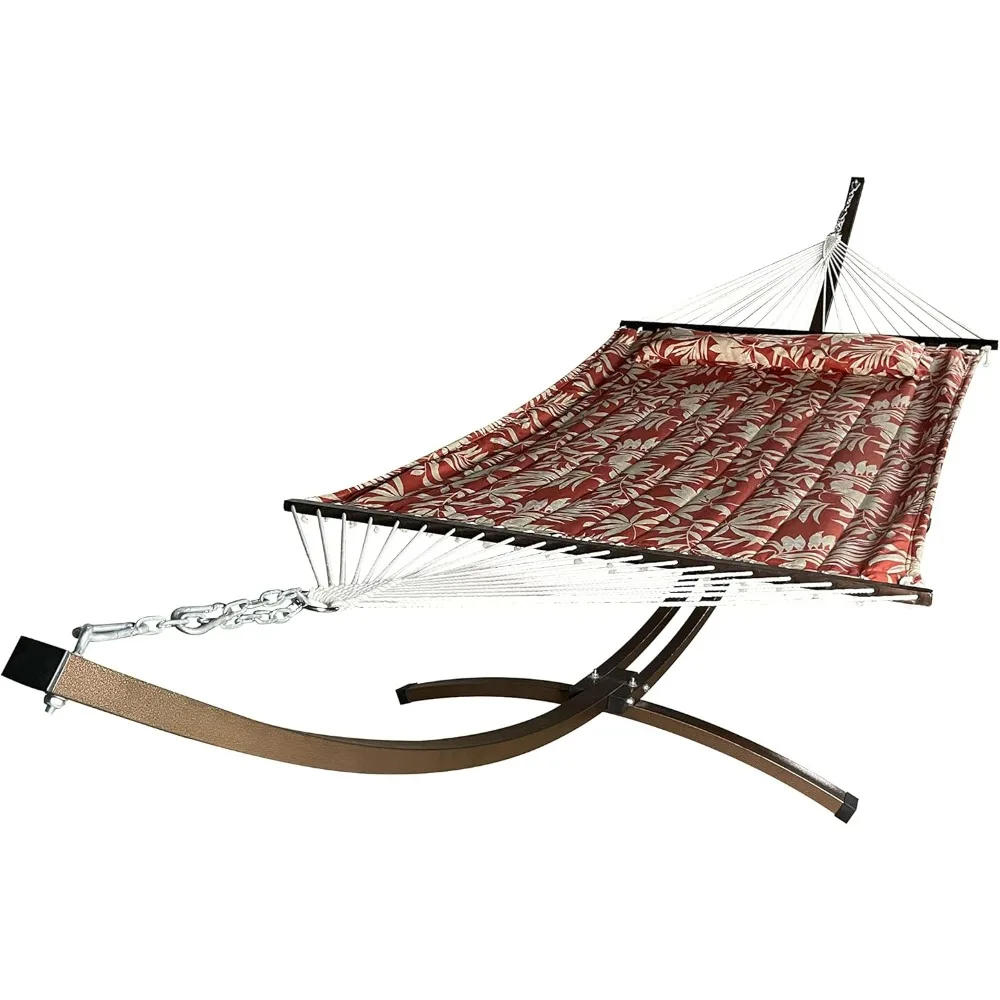
Camping Hammock Sets with Bug Net, Ultralight Camping Hammock Sets
$139.72 Select options This product has multiple variants. The options may be chosen on the product pageDouble / Two Person Hammock Sets, Rope Hammock Sets
Double Traditional Cotton Rope Hammock with Extension Chains – 450 lbs Capacity for Backyard & Patio$292.98 Select options This product has multiple variants. The options may be chosen on the product page- $270.16 Select options This product has multiple variants. The options may be chosen on the product page
Double / Two Person Hammock Sets, Fabric Hammock Sets
$231.51 Select options This product has multiple variants. The options may be chosen on the product page
Expert Care Tips: Maximizing Your Hammock’s Lifespan
No matter which material you select, proper care significantly extends your hammock’s life:
- Material-Specific Cleaning:
- Cotton: Gentle hand washing with mild soap, thorough drying before storage
- Polyester/Nylon: Hose down and brush lightly for spot cleaning
- Acrylic: Mild soap solution, rinse thoroughly, no scrubbing needed
Mesh: Simply rinse with water, no soap usually required
Storage Recommendations:
- Store indoors during extended bad weather or off-seasons
- Ensure hammock is completely dry before storage
- Store in breathable bag rather than plastic to prevent mildew
Hang in storage rather than fold when possible to prevent creases
Weather Protection Strategies:
- Consider a hammock cover for quick protection
- Use quick-release hanging systems for rapid removal before storms
- Position hammocks where they receive some weather protection
Consider the perfect hammock placement for your home or garden to maximize protection
Regular Inspection Routine:
- Check stitching and stress points monthly
- Examine chain or rope connections before each use
- Look for early signs of UV damage or material weakening
Address small tears or fraying immediately before they spread
Common Issue Solutions:
- Mildew: Solution of 1 part vinegar to 4 parts water for gentle cleaning
- Minor fading: Fabric refresher products for synthetic materials
- Small tears: Repair tape or patches designed for specific materials
With proper care, even moderately priced hammocks can provide many seasons of enjoyment, making material maintenance knowledge almost as important as the initial selection.
Our Material Testing Process: How We Evaluate Outdoor Hammocks
At Outside Luxe, we understand that theoretical material properties don’t always translate to real-world performance. That’s why we implement a comprehensive testing protocol for all hammock materials in our collection:
Our testing process subjects hammock materials to accelerated weathering conditions that simulate years of outdoor exposure in just months. We measure color fastness, tensile strength retention, and water resistance both before and after this simulated aging process.
We also conduct practical testing with real users across different body types and usage patterns to evaluate comfort, noise during use, and general satisfaction. Materials must excel in both laboratory and real-world testing to earn our recommendation.
Additionally, we gather long-term performance data from customers through follow-up surveys to identify how different materials perform over multiple years in various climate conditions. This feedback loop ensures our recommendations reflect actual durability, not just theoretical strengths.
This rigorous evaluation process allows us to confidently recommend materials that will provide the perfect balance of performance characteristics for your specific outdoor setting.
Making Your Final Decision: Balancing Material Qualities with Your Priorities
As you consider the perfect hammock material for your needs, remember that there’s no universally “best” option—only the best match for your specific situation. Consider these final decision-making tips:
Prioritize the factors most important to your usage pattern. If you’ll leave your hammock outdoors year-round, weather resistance should outweigh minor comfort differences. Conversely, if you’ll only use it occasionally and store it properly, comfort might be your top concern.
Consider your willingness to perform maintenance. Be honest about whether you’ll actually bring your hammock inside before storms or if you need something that can withstand unexpected weather.
Match material properties to your local climate challenges. Desert environments demand excellent UV resistance, coastal areas require salt-air corrosion resistance, and humid regions need superior mold resistance.
Remember that quality within any material category varies significantly. A premium version of a “less suitable” material often outperforms a low-quality version of the “ideal” material. Invest in the best quality you can afford within your chosen material type.
With the knowledge you’ve gained about hammock materials, you’re now equipped to make an informed decision that balances performance, comfort, and longevity—ensuring countless perfect afternoons swaying gently in your ideal outdoor retreat.

